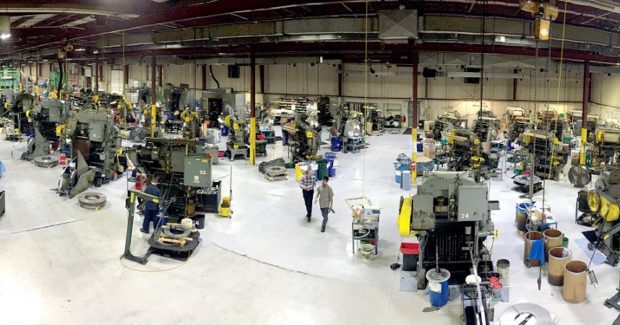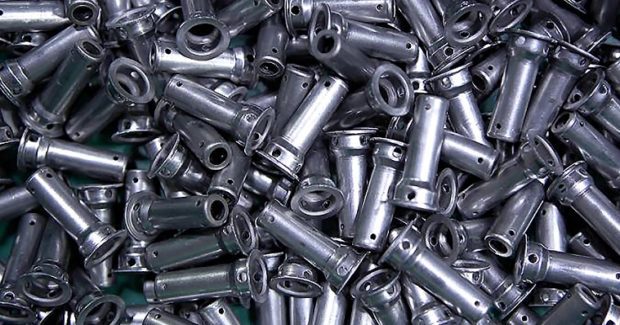How to Deburr Piercing Holes in Deep Draw Stamping
Precision Stamping Company had to remove the heavy burrs left on pierced holes in the stepped sections of a deep drawn spring cup that is flared at the top of a narrower body diameter. Instead of sending the parts outside for expensive thermal deburring or tumbling, they turned to a custom ball hone to do the job themselves. Here’s how they did it.
Posted: April 23, 2018
For metal stamping operations the very nature of the shearing process used to create intricate, tight tolerance piercings inevitably creates burrs that require a secondary finishing step to remove them. This is particularly true for parts with wall thicknesses in excess of 0.005 in, which often results in heavier burrs. As a result, stamping operations must decide how to most efficiently remove the burrs. For many press rooms, this means manually deburring each part in-house. However, finishing, smoothing, and removing burrs by hand not only significantly increases the manufacturing time, but is also prohibitive in terms of labor and employee ergonomics. Large production runs make this manual option even less viable. Another alternative is to send parts out for a secondary finishing step, such as thermal deburring or tumbling. While these techniques effectively remove excess material, this method also increases the time to ship and return the parts, as well as the added cost. And both techniques are known to mar the surface of the part.
For Jesse Parke of Precision Stamping Company (Howell, MI), which specializes in deep drawn parts, this left only one alternative: finding a more efficient and inexpensive method to complete the deburring work in-house. Founded in 1946, Precision Stamping manufactures deep drawn metal parts for automotive, industrial, and military parts providers worldwide. Among the largest metal stampers in the Midwest, they primarily produce products such as oil-cooler lines and quick disconnects for the automotive industry. According to Parke, a third-generation stamping engineer, they can pierce holes in sheet metal blanks and formed shells using complex machinery and setups that are “flirting on the edge of what’s possible and what’s wishful thinking.”
However, the production of hundreds of thousands of stamped parts with tight tolerances and intricate piercings – as low as 0.078 in on one recent job – still creates challenges when it comes to deburring. Parke points to one particular recent part, a spring cup that required a unique operation. Like many deep drawn parts, the part was flared at the top with a narrower diameter for the body. The part specification included piercing a hole in each of the “stepped” sections, leaving a heavy burr. To resolve the problem, the shop initially opted to send the parts out for thermal deburring, a process that removes the excess material by vaporizing and burning it off. However, this step added time, vendor expense, shipping expense, and often required cleaning off black carbon residue once the parts were returned to the shop. Eager to discover a more efficient alternative, Parke began to explore and research options to keep the parts in-house.
Although he was initially unable to find a viable option, at a trade show in 2015 one of his colleagues recommended a Flex-Hone ball hone from Brush Research Manufacturing Co., Inc. (Los Angeles, CA). This self-centering, self-aligning, and self-compensating ball hone features abrasive globules attached to flexible filaments along a central shaft and can be used in any rotating spindle. It is used prominently in CNC machining operations for deburring and surface finishing of metal parts with cylindrical bores or through-holes. Although it is often used with automated equipment, the abrasive tool can also be used with a drill. It is sold through a worldwide network of distributors and is available in a broad range of sizes, abrasives and grits, but for this particular application, none of the standard options would work for the spring cup due to its two-stepped design.
So Parke decided to contact Brush Research and explain to their engineers that this job required a “stepped” hone that would work with the specific dimensions of the part. “With the part being stepped, I was not sure if we would need a custom brush or what the ideal choice would be,” he recalls. He learned how the engineers could create custom hones to meet the needs of unique applications, including custom sizes – from extremely large diameter to miniature – as well as unique configurations, such as tapered or stepped. They responded quickly with a tool that met the shop’s needs. Now, after the parts are stamped and cleaned, they are transferred to a nest for piercing. When that is completed, they are moved to another nest, where a stepped ball hone is inserted and rotated using an automated pneumatic drill. The same operation is repeated in the opposite direction to ensure maximum deburring, as well as maximize brush life. The part then drops through an escapement in the machine as finished goods.
Since Precision Stamping started using the custom ball hone, Parke described how they have experienced a steady increase in production output. In one six-hour period, operators were able to run 8,000 pieces – and not one needed additional deburring. “This ball hone is definitely helping us keep costs down by not having to send parts out for thermal deburring,” he said. “If you don’t have to do that, you’ve saved all the part-handling time and all that money. Now we can deburr in-house and the parts look ten times better than what we were getting before with the thermal deburring.” Since the jobs that make it to Precision Stamping are the more complex, technical ones, with the simpler open-tolerance jobs going overseas, Parke said he expects to use custom ball hones for future jobs as well. “I see that only increasing as we match the correct ball hones with the correct tooling.”
Precision Stamping Company, 1244 Grand Oaks Drive, Howell, MI 48843, 517-546-5656, Fax: 517-546-4842, www.precisionstamping.com.
Brush Research Manufacturing Co., Inc., 4642 Floral Drive, Los Angeles, CA 90022, 323-261-2193, Fax: 323-268-6587, info@brushresearch.com, www.brushresearch.com.











